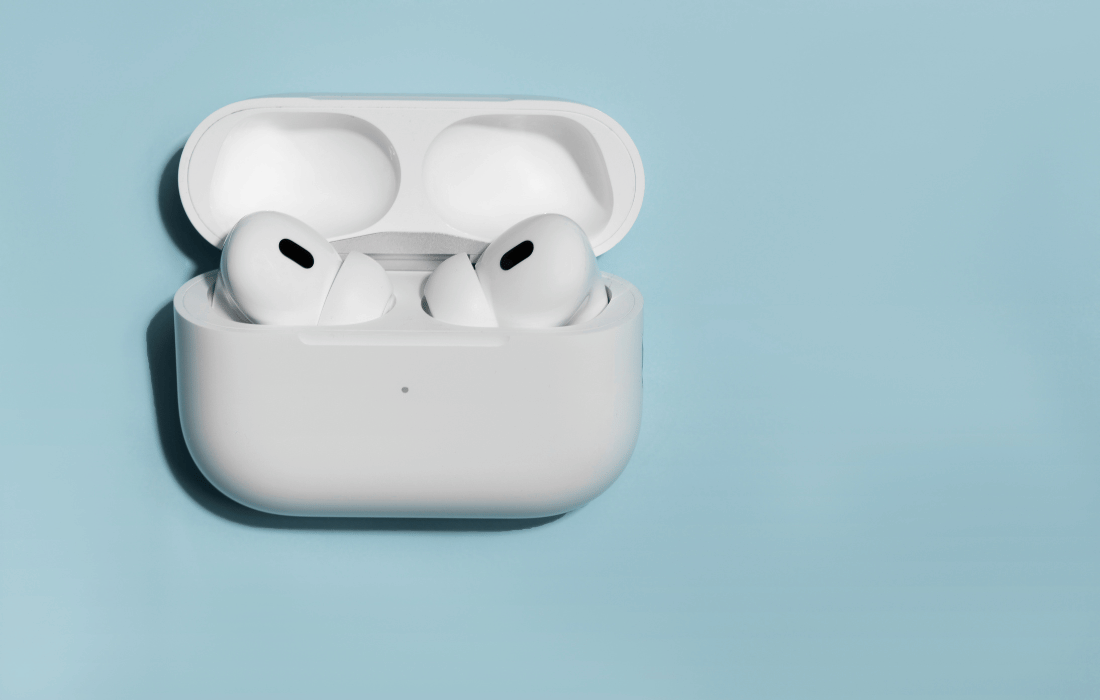AirPods have become the gold standard of wireless earbuds, thanks to their seamless connectivity and sleek design. But beneath their convenience lies a growing concern: electromagnetic field (EMF) radiation. As more people wear wireless devices for hours a day, it’s crucial to understand the potential risks involved, particularly when it comes to long-term exposure to EMF radiation. In this comprehensive article, we will explore how AirPods expose the brain to potentially harmful levels of radiation, how they affect the blood-brain barrier (BBB), why Aires Tech is a trusted solution, and why wired headphones remain the safest option for audio devices.
How AirPods Work and Why They Emit EMF Radiation
AirPods operate using Bluetooth technology, a type of wireless communication that requires the transmission of data using non-ionizing EMF radiation at around 2.4 GHz. Non-ionizing radiation is the same frequency used by devices like Wi-Fi routers, cell phones, and microwaves. Still, AirPods are unique in placing the radiation-emitting source directly in the ear canal, close to the brain. This proximity makes understanding how they might affect neural tissues and brain health crucial.
 AirPods are constantly exchanging signals between each other and the connected device. Each AirPod not only receives signals from the device but also communicates with its counterpart to synchronize audio playback. This means that there is two-way communication of radiofrequency (RF) signals happening through the brain. Although non-ionizing radiation is generally considered safer than ionizing radiation, there are growing concerns about the long-term effects of cumulative low-level exposure to RF radiation, especially when it’s so close to critical body organs like the brain.
AirPods are constantly exchanging signals between each other and the connected device. Each AirPod not only receives signals from the device but also communicates with its counterpart to synchronize audio playback. This means that there is two-way communication of radiofrequency (RF) signals happening through the brain. Although non-ionizing radiation is generally considered safer than ionizing radiation, there are growing concerns about the long-term effects of cumulative low-level exposure to RF radiation, especially when it’s so close to critical body organs like the brain.
The Blood-Brain Barrier and EMF Radiation: What We Know
The blood-brain barrier (BBB) is a protective shield that prevents harmful substances from crossing into the brain from the bloodstream. The BBB is vital for maintaining the brain’s delicate environment, protecting it from toxins, bacteria, and other harmful agents. However, recent studies suggest that EMF radiation, even at non-ionizing levels, can compromise the integrity of the BBB.
Several studies have demonstrated that exposure to EMF radiation increases the permeability of the BBB, allowing larger molecules—normally blocked by the barrier—to enter the brain tissue. This increase in permeability raises significant concerns, particularly with long-term exposure to EMF radiation emitted by devices like AirPods that are worn near the brain for hours each day.
Additionally, a Swedish study found that EMF exposure caused leakage of albumin, a type of protein, into the brain—a clear indication that the BBB was compromised. While much of this research has been conducted on animals, the implications for humans are troubling. If AirPods compromise the BBB, they could potentially allow toxins to penetrate deeper into the brain, leading to neurodegenerative diseases, cognitive impairments, or even increasing the risk of brain tumors.
Health Risks Linked to AirPods: Headaches, Tinnitus, and Neurological Issues
The potential risks of AirPods extend beyond the compromise of the blood-brain barrier. Headaches, tinnitus, and other neurological symptoms are frequently reported by users who wear AirPods for extended periods. Some users report experiencing these symptoms within weeks of using the wireless earbuds.
According to Dr. Jerry Phillips, a biochemist at the University of Colorado, “the placement of AirPods directly in the ear canal exposes tissues in the head to relatively high levels of radio-frequency radiation,” which can lead to abnormal cell functioning. This constant exposure is especially problematic for individuals who wear their AirPods for hours a day—whether for work, commuting, or exercise.
Several forums, including the official Apple discussion boards, are flooded with reports from users complaining of these issues. While anecdotal evidence isn’t conclusive proof, these complaints align with broader concerns about the effects of prolonged RF radiation on human health. Tinnitus, in particular, is frequently mentioned as a symptom associated with EMF exposure, and it occurs when users report hearing constant ringing or buzzing sounds in their ears without an external source.
The Real Issue with AirPods: Consistent Radiation Exposure
Another alarming aspect of AirPods is the consistency of radiation exposure. When a user is wearing AirPods, the wireless earbuds are constantly emitting RF radiation. This means there is continuous low-level radiation exposure close to the brain, whether or not audio is playing. Even when the user isn’t streaming music or making calls, the AirPods remain connected to the device, still emitting radiation to maintain that connection.
What’s more concerning is that SAR levels (Specific Absorption Rates)—which measure how much radiation the body absorbs—vary between each AirPod. A 2021 discussion in the Apple Support Community noted that the left AirPod emits double the SAR of the right AirPod in some instances. This inconsistency raises more questions about safety, especially for those who frequently wear both AirPods.
Are AirPods Linked to Cancer?
The potential link between RF radiation from devices like AirPods and cancer is still a subject of ongoing research. However, the World Health Organization’s International Agency for Research on Cancer (IARC) classified RF radiation as “possibly carcinogenic to humans” in 2011, based on evidence linking it to an increased risk of gliomas, a type of brain tumor.
While definitive studies on AirPods specifically are still lacking, the type of radiation emitted by AirPods is similar to that from cell phones, which have been studied more extensively. The National Toxicology Program (NTP) conducted a study that showed a clear association between prolonged exposure to RF radiation and the development of tumors in rats. Though AirPods emit lower levels of radiation than cell phones, their proximity to the brain and the constant exposure are reasons for concern.
SAR Levels of AirPods: How Much Radiation Are We Talking About?
 When we talk about the radiation emitted by AirPods, it’s essential to understand “Specific Absorption Rate” (SAR). SAR measures the rate at which the body absorbs RF energy from a device. According to the FCC, the maximum allowed SAR level for any device is 1.6 W/kg over a volume of 1 gram of tissue.
When we talk about the radiation emitted by AirPods, it’s essential to understand “Specific Absorption Rate” (SAR). SAR measures the rate at which the body absorbs RF energy from a device. According to the FCC, the maximum allowed SAR level for any device is 1.6 W/kg over a volume of 1 gram of tissue.
Unfortunately, Apple does not prominently publish the SAR values for AirPods, and obtaining accurate data can be difficult. However, based on FCC reports, some AirPods can emit SAR levels as high as 0.466 W/kg, with notable variations between each earbud. While this may seem low compared to the legal limit, it’s worth considering that these levels were set before wireless devices became as ubiquitous as they are today. Furthermore, the radiation is emitted directly into the ear canal, which puts it much closer to the brain than other devices, increasing the risk.
Why Wired Headphones Are the Safest Choice
For those of us who are concerned about the potential health risks associated with wireless devices, the most straightforward solution is to use wired headphones. Unlike wireless earbuds like AirPods, wired headphones don’t emit EMF radiation. They rely on physical connections to transmit sound, eliminating the need for RF signals entirely.
Some might argue that wired headphones are less convenient or trendy, but when it comes to protecting your brain and body from daily exposure to harmful EMFs, the benefits far outweigh the slight inconvenience. Wired headphones offer crystal-clear sound quality without the risk of continuous radiation exposure near the brain.
Over-the-Ear Bluetooth Headphones: A Safer Wireless Alternative
For those who still prefer wireless devices but want to minimize EMF exposure, over-the-ear Bluetooth headphones provide a safer alternative to AirPods. With over-the-ear models, the main sources of

EMF radiation—the Bluetooth transmitters—are located further from the brain. This reduces the intensity of radiation exposure compared to in-ear devices like AirPods.
Moreover, you can take further steps to reduce EMF exposure by using Aires Tech Lifetune products. Aires Tech’s patented technology helps neutralize the harmful effects of EMF radiation, converting it into a form that is more compatible with the human body. By attaching a Lifetune One to the outside of your over-the-ear headphones, you can significantly reduce your overall EMF exposure.
Aires Tech: The Proven Solution to EMF Protection

For those who can’t avoid wireless technology, Aires Tech offers some of the best EMF protection solutions on the market. Their Lifetune Flex and Lifetune One devices are specifically designed to neutralize harmful EMF emissions from wireless devices. By using advanced nanotechnology, Aires Tech products restructure EMF waves into a form that’s less biologically damaging.
While these solutions can be used with over-the-ear headphones, they aren’t suitable for AirPods due to their in-ear placement. This is one more reason to reconsider using AirPods in favor of safer alternatives like wired or over-the-ear headphones with EMF protection.
Other Ways to Protect Yourself from EMF Radiation
Aside from switching to wired headphones or using EMF protection devices, there are other ways to reduce your exposure to harmful radiation:

Save 25% on all Aires Tech EMF protection products with code “kyletothemoon” Limit Duration of Use: If you must use AirPods, try to limit the time you spend wearing them. Removing them when not in use1. Limit Duration of Use: If you must use AirPods, try to limit the time you spend wearing them. Removing them when not in use can minimize your cumulative exposure to EMF radiation.
Use Airplane Mode: If you’re just using AirPods to listen to music or podcasts stored on your device, switch your phone to airplane mode. This will disable Bluetooth and other wireless connections, reducing radiation exposure.
Keep Devices at a Distance: When using AirPods, keep the connected device (like your smartphone or tablet) away from your body. The further the device is from you, the lower the intensity of radiation.
Turn Off AirPods When Not in Use: AirPods are constantly emitting radiation to maintain their connection, even when you’re not actively using them. Turning them off or taking them out when not in use can cut down on unnecessary exposure.
Conclusion: Protect Yourself from EMF Exposure
In today’s digital age, it’s nearly impossible to avoid EMF radiation entirely, but you can take steps to reduce your exposure. While AirPods offer undeniable convenience, they come with potential long-term risks, especially given the proximity of their radiation to your brain. The fact that they communicate through the brain raises valid concerns about compromising the blood-brain barrier, which is critical for protecting your brain from toxins.
Switching to wired headphones or over-the-ear Bluetooth headphones with Aires Tech Lifetune protection is a safer alternative. These choices provide a balance between convenience and health-conscious practices.
As technology continues to evolve, it’s crucial that we remain vigilant about its effects on our health. While regulatory standards like SAR levels provide a baseline for safety, they are often outdated and may not reflect the true risks of modern wireless devices. By staying informed and taking proactive steps to reduce your EMF exposure, you can protect yourself from potential health risks without sacrificing your enjoyment of technology.














